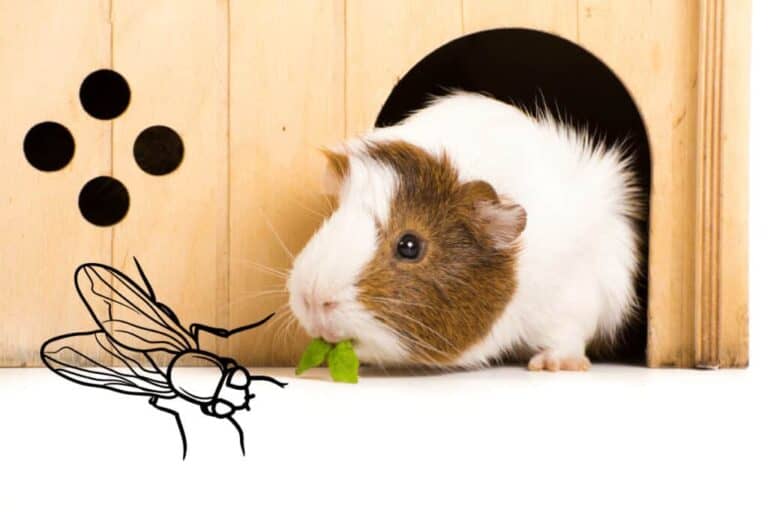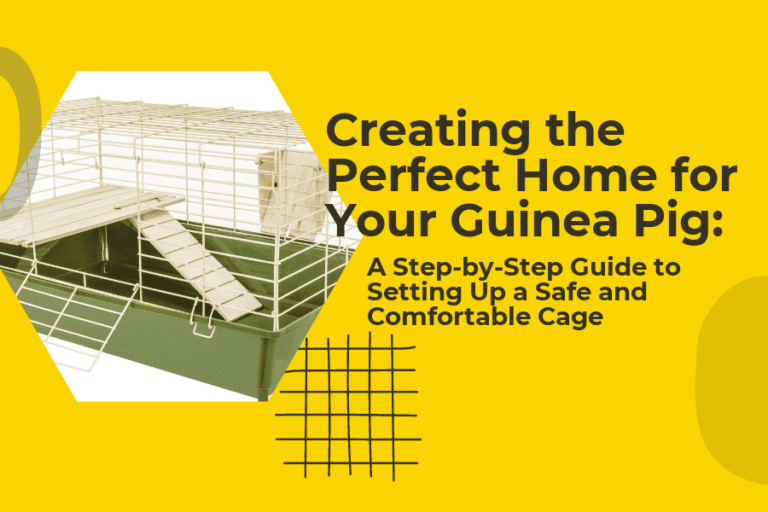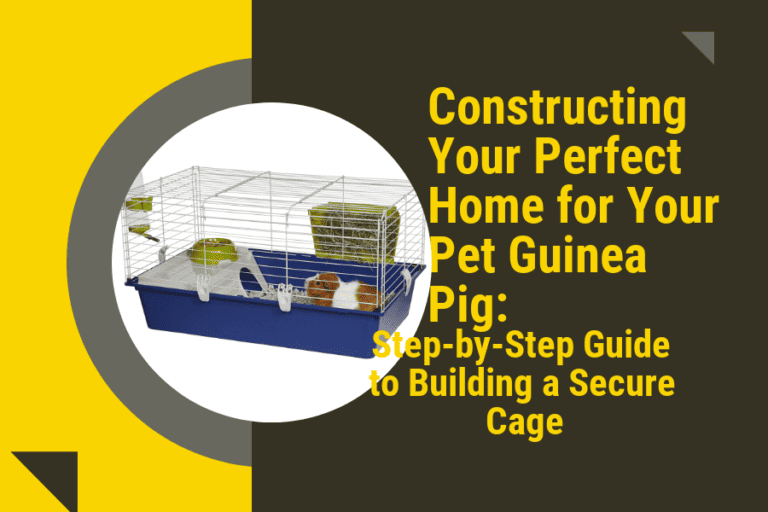Ensuring Your Guinea Pig Has Plenty of Space: How Big Should Your Guinea Pig Cage Be?
Are you looking for the perfect home for your guinea pig? You’ll want to make sure your furry friend has enough space to play, explore, and relax. But just how big should a guinea pig cage be?
In this article, we’ll explore the factors to consider when determining the size of a guinea pig cage and offer some tips on how to make sure your guinea pig has plenty of room to live a happy and healthy life.
From the amount of space required to the type of materials to use, we’ll cover everything you need to know to ensure your guinea pig has the best home possible. So read on to find out more about how to give your guinea pig plenty of space.
What Is the Minimum Size for a Guinea Pig Cage?
When it comes to guinea pig cages, size matters. The minimum size recommended for a guinea pig cage is 7.5 square feet. Ideally, the larger the cage the better as it will give your guinea pig more space to explore and play.
The cage should be long enough so your guinea pig has enough space to run, as well as tall enough so they can stand up on their hind legs and stretch out. A cage that is too small can lead to boredom and stress, which can cause health problems.
Also, consider the type of material you use for the guinea pig cage. It is best to use materials that are easy to clean, such as galvanized wire, powder-coated metal, or PVC plastic. Avoid using any materials that contain toxins, as these can be harmful to your guinea pig. Lastly, make sure the cage is well-ventilated and has plenty of hiding places for your pet. This will give your guinea pig a safe and comfortable place to relax and play.
In conclusion, the minimum size for a guinea pig cage should be 7.5 square feet. Consider the type of material you are using for the cage and make sure it is well-ventilated and has plenty of hiding places. With the right size and material, your guinea pig will have a safe and comfortable home.
What to Consider When Choosing a Guinea Pig Cage
Are you looking for the perfect home for your guinea pig? You’ll want to make sure your furry friend has enough space to play, explore, and relax. But just how big should a guinea pig cage be? In this article, we’ll explore the factors to consider when determining the size of a guinea pig cage and offer some tips on how to make sure your guinea pig has plenty of room to live a happy and healthy life.
To start, guinea pigs are social animals and do best when kept in pairs or small groups, so it’s important to ensure you have enough space for more than one guinea pig. In general, experts recommend each guinea pig should have at least 7.5 square feet of floor space. So if you are planning on keeping more than one guinea pig, make sure the cage is big enough to accommodate them all.
When it comes to the type of material to use, the most important thing is that the cage is safe and secure. You’ll want to make sure the cage has no sharp edges or gaps that your guinea pig can escape through. It’s also a good idea to stick to materials that are easy to clean, such as metal wire, plastic, or glass.
By taking into consideration the size and material of the cage, you can ensure your guinea pig has enough room to live a happy and healthy life. Remember, the larger the cage, the better for your guinea pig. So make sure you do your research and provide your furry friend with the best possible home.
What Types of Materials to Use for a Guinea Pig Cage
When it comes to building your guinea pig’s ideal home, it’s important to choose the right type of materials. Plastic or wire cages are typically the best options, as they provide plenty of ventilation and are easy to clean. You’ll also want to make sure the bars are spaced correctly so your guinea pig can’t escape. Wire cages may be more expensive, but you’ll want to invest in one if you plan on having more than one guinea pig in the same space.
If you’re looking for something a bit more creative, you can also create a homemade cage out of wood or cardboard. While these materials may not be as easy to clean as plastic or wire, they can give your guinea pig’s home a more natural feel and provide plenty of room to explore. You’ll just want to ensure there are no sharp edges and that your guinea pig can’t get its claws caught in any of the materials.
Overall, when it comes to choosing the right type of materials for your guinea pig cage, you should take your time and consider all of your options. Plastic and wire cages will be the most practical for easy cleaning and ventilation, but if you’re looking for something more creative, wood and cardboard can be great options. With the right materials, your guinea pig can have a comfortable and safe space to call home.
How to Make a Guinea Pig Cage Roomier
Are you looking for the perfect home for your guinea pig? You’ll want to make sure your furry friend has enough space to play, explore, and relax. But just how big should a guinea pig cage be? In this article, we’ll explore the factors to consider when determining the size of a guinea pig cage and offer some tips on how to make sure your guinea pig has plenty of room to live a happy and healthy life.
When deciding on the size of a guinea pig cage, you’ll want to take into account the number of guinea pigs you have, as well as the size of the cage itself. The ideal guinea pig cage should be at least 7.5 square feet for a single guinea pig, with an additional 4 square feet for each additional guinea pig. Furthermore, the cage should be at least 18 inches tall to provide enough space for them to stand up on their hind legs.
Once you have the size of the cage figured out, you can start making it roomier. For instance, you can add vertical space by adding shelves, ramps, hideaways, and ladders. This will give your guinea pig plenty of opportunities to explore and move around. Additionally, you can add more substrate material to the bottom of the cage, such as bedding or hay, to give your guinea pig a comfortable place to relax and play. Lastly, make sure to provide plenty of toys and treats for your guinea pig to keep it active and entertained.
By taking all of the necessary factors into consideration when purchasing a guinea pig cage and adding the appropriate accessories and elements, you can create a much roomier and comfortable home for your guinea pig. Not only will this create a safe and stimulating environment for your furry friend, but it will also ensure your guinea pig is living a happy and healthy life.
What Accessories to Include in a Guinea Pig Cage
In addition to the size of a guinea pig cage, it’s important to include the right accessories. First and foremost, guinea pigs need a comfortable bedding material. Most pet stores carry special beddings for small rodents, which are typically made from materials like wood shavings, paper, and straw.
You’ll also want to include a hidey house or two to give your guinea pig a sense of security and privacy. If you want to give your guinea pig plenty of exercise, you can also invest in a wheel or two, as well as plenty of chew toys.
When it comes to toys, look for items made from natural materials like wood and hay, as they are less likely to harm your guinea pig’s teeth and digestive system. Lastly, make sure you provide your guinea pig with plenty of fresh hay and vegetables, as they are essential for a healthy diet.
By considering the size of the cage, the type of materials to use, and the right accessories, you can create a comfortable and safe home for your guinea pig. With a little bit of preparation and the right set-up, your guinea pig will have plenty of room to play, explore, and snuggle up for a nap.
Tips for Cleaning and Maintaining a Guinea Pig Cage
Once you have the perfect home for your guinea pig, you’ll want to make sure it stays clean and safe for your furry friend. Cleaning and maintaining a guinea pig cage is an important part of providing a healthy environment. Here are some tips to keep in mind when caring for your guinea pig’s home:
Clean the cage regularly. You should clean the cage at least once a week, and spot clean on a daily basis. Spot cleaning involves removing soiled bedding, food, and water bowls, and wiping down the walls, floors, and other surfaces with a mild soap or vinegar solution.
Change the bedding regularly. Changing the bedding weekly will help keep the cage fresh and clean. Choose a natural fiber bedding like hay or wood pellets. Avoid using fabrics and carpets as they can trap bacteria and other allergens.
Check for dangerous objects. When cleaning and maintaining the cage, check for any objects that may be a hazard to your guinea pig. This includes sharp edges, wires, or anything that could potentially harm your pet.
By following these simple tips for cleaning and maintaining a guinea pig cage, you’ll be able to provide a safe and healthy environment for your furry friend to live in. In addition, you’ll be able to ensure that your guinea pig has plenty of space to roam, play, and explore.







